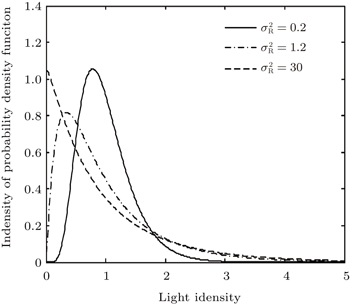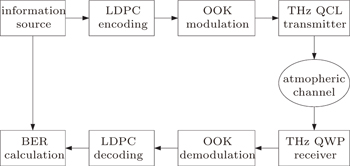† Corresponding author. E-mail:
‡ Corresponding author. E-mail:
Project supported by the National Key Basic Research Program of China (Grant No. 2014CB339803), the National High Technology Research and Development Program of China (Grant No. 2011AA010205), the National Natural Science Foundation of China (Grant Nos. 61131006, 61321492, and 61204135), the Major National Development Project of Scientific Instrument and Equipment (Grant No. 2011YQ150021), the National Science and Technology Major Project (Grant No. 2011ZX02707), the International Collaboration and Innovation Program on High Mobility Materials Engineering of the Chinese Academy of Sciences, and the Shanghai Municipal Commission of Science and Technology (Grant No. 14530711300).
Atmospheric absorption, scattering, and scintillation are the major causes to deteriorate the transmission quality of terahertz (THz) wireless communications. An error control coding scheme based on low density parity check (LDPC) codes with soft decision decoding algorithm is proposed to improve the bit-error-rate (BER) performance of an on-off keying (OOK) modulated THz signal through atmospheric channel. The THz wave propagation characteristics and channel model in atmosphere is set up. Numerical simulations validate the great performance of LDPC codes against the atmospheric fading and demonstrate the huge potential in future ultra-high speed beyond Gbps THz communications.
Along with the rapid development of terahertz (THz) sources and detectors, recent advances in THz wave technologies have attracted more and more attention due to the huge bandwidth, large capacity, and its enormous potential for applications on wireless communications. The higher carrier frequency and broader bandwidth of THz band can contain more information, and unallocated spectrum resources can avoid much interference, congestion, which are competitive advantages for ultra-high speed data transmission in comparison with microwave and millimeter communications.[1,2] However, atmospheric absorption, scattering, and scintillation will limit the THz communication transmission distance and data rate. THz beams are sensitive to the properties of the medium and will be influenced inevitably by atmospheric turbulence when propagating through the atmosphere near the ground.[3,4] The path loss and atmospheric scintillation will seriously deteriorate the signal-to-noise ratio (SNR) and degrade the bit-error-rate (BER) performance of THz wireless communication links. Scintillation theory has been proposed in many practical light propagation applications and the atmospheric turbulence is in accordance with the scintillation index.[5] Error control coding technology can be an efficient solution to improve the system performance in similar channels.[6,7]
Low density parity check (LDPC) codes[8] are considered to be one of the most efficient forward error correction (FEC) schemes because of their excellent performance approaching Shannon’s limit[9] and significant low decoding complexity when decoded with the belief-propagation (BP) algorithm or sum-product algorithm (SPA).[10] Applications of LDPC codes on optical communications have been investigated in various methods and exhibit great advantages against channel fading.[11–13] However, to the best of our knowledge, there have been few papers reported about the THz channel coding technology so far. Consequently, it is obligated to apply some powerful channel coding schemes to ensure the THz wireless link quality and LDPC codes are good candidates.
In this paper, we propose an LDPC code scheme to improve the BER performance of an on-off keying (OOK) modulated THz wireless communication system based on quantum-cascade laser (QCL) as the transmitter and quantum-well photodetector (QWP) as the receiver[14,15] and verified the feasibility of the scheme. The paper is structured as follows. In Section 2, the THz wave propagation characteristics in atmosphere are analyzed and the related communication channel model is set up. Then LDPC decoder design is introduced in Section 3. In Section 4, numerical simulations of LDPC codes with soft decision decoding algorithm in different atmospherical conditions, propagation distance, and bit rate are carried out. Simulation results demonstrate the great performance of LDPC codes in future ultra-high speed THz wireless communications. Concluding remarks wrap up this paper in Section 5.
A point-to-point THz wireless communication system using intensity modulation and direct detection (IM/DD) with OOK modulation was observed[15] and its simplified block diagram is shown in Fig.



The QWP receiver noise is caused by shot noise, thermal noise and dark current. It is assumed that dark current and shot noise is negligible because thermal noise is dominated in the total noise, so the noise variance 

Channel characteristics at THz (0.06 THz∼1 THz) band communication has been fully studied in recent years.[17,18] In the contrary, there is no enough theory about THz wireless channel characteristics beyond 1 THz due to lack of related experimental measurements. The THz signal transmission through atmospheric channel is inevitably disrupted by atmospheric turbulence, attenuation, and geometric loss. Several statistical models have been reported to estimate the atmospheric turbulence effects,[19] and gamma–gamma distribution has been accepted as the most suitable model for a wider range of turbulence conditions from weak to strong in various communication systems.[20] According to the gamma–gamma model, the probability density function (PDF) of the received optical irradiance can be given by[19,20]








To simplify the discussion, 


 | Fig. 2. The probability density function (PDF) of gamma–gamma models in different turbulence conditions. |
The THz communication system based on THz QCL and THz QWP uses two off-axis parabolic mirrors in the wave propagation path to collect the optical energy and change the optical path.[15] Therefore, there is approximately no geometrical spreading loss in the system and it can be negligible. Path loss caused by atmospheric absorption and some additional loss including transmission loss through the polyethylene medium windows and reflection loss from the mirrors are considered. Then the total atmospheric attenuation can be express as

The LDPC code is a special linear group of codes with very sparse parity-check matrix. Many constructor methods for the parity check matrix and efficient encoding schemes with linear time have been proposed.[21–23] In this paper, the quasi-cyclic LDPC codes presented by IEEE 802.16e standard are adopted to analyze the coding gain in different conditions as a reference.[24] The LDPC codes are constructed by the base check matrix and encoded by an iterative encoding method with linear time encoding complexity.
The LDPC soft decision decoding algorithm is also a crucial point to optimize the system performance. The first step of decoding algorithm is the initialization step, which must calculate the knowledge of the log-likelihood ratio (LLR) for each received incident information bit y at the transmitted bit x = {0,1},[25]

It is assumed that perfect channel side information (CSI) denoted by h in Eq. (

Assume that “0” and “1” are transmitted in identical probability, then we can derive the priori LLR expression from Eqs. (

After the initialization step, the iterative LDPC decoding operates by passing messages between variable nodes and check nodes according to the equivalent Tanner graph of the parity check matrix until correcting the error bits or reaching the maximum iterations.[10]
To illustrate BER performance of LDPC codes in THz wireless channel through atmosphere, plenty of numerical simulations have been carried out. The key values in the simulations are based on practical channel parameters obtained from experimental scenario, as shown in Table 
| Table 1. Constants and system parameters. . |
The simulation results are shown in Fig. 
From simulation results and evaluation, we can see adverse impact caused by atmospheric absorption and scintillation is evident in THz communication system. LDPC codes can be an efficient solution to improve the BER performance and increase the communication distance and data rate. The THz wave is quite suitable for ultra-high speed indoor wireless communications and its data bit rate can be expected to exceed Gbps in LDPC coded systems. Large code length and low code rate LDPC codes are recommended in THz wireless communication. However, longer code length and lower code rate will result in a longer latency and information transfer rate. The longer block lengths increase the system implement complexity and hardware resources and reduce data throughput for high speed data transmission. Under the condition of abundant bandwidth resources, a rational LDPC code should be chosen to apply to practical THz wireless applications considering system complexity, data rate, and transmission delay, besides BER performance.
In conclusion, we present an efficient error control coding scheme based on powerful LDPC codes over a THz wireless link through atmospheric channel with THz QCL as emitter and THz QWP as detector. The introduction of LDPC codes as the channel coding is proved to be considerably significant to reduce the atmospheric attenuation and turbulence effects. Meanwhile, LDPC codes contribute great improvements on THz communication distance and data bit rate and the overall transmission rate is promised to be beyond Gbps. Though LDPC codes might have some disadvantages, they still can be a promising and potential solution to develop the practical applications in THz indoor wireless communications along with the rapid development of integrated circuit, semiconductor device, and manufacture technology.
| 1 | |
| 2 | |
| 3 | |
| 4 | |
| 5 | |
| 6 | |
| 7 | |
| 8 | |
| 9 | |
| 10 | |
| 11 | |
| 12 | |
| 13 | |
| 14 | |
| 15 | |
| 16 | |
| 17 | |
| 18 | |
| 19 | |
| 20 | |
| 21 | |
| 22 | |
| 23 | |
| 24 | |
| 25 |







